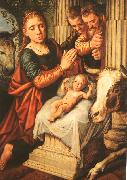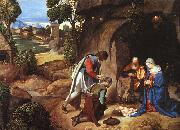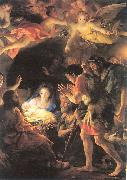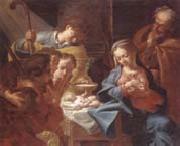
|
Pieter Aertsen
|
|||
|
|
|||
| 1508-1575 Flemish Pieter Aertsen Galleries Dutch painter and draughtsman, active also in the southern Netherlands. He probably trained in his native Amsterdam but early on moved to Antwerp, where he enrolled in the Guild of St Luke as a master in 1535. In 1542 he was granted citizenship of the city. Among his pupils in Antwerp were Johannes Stradanus and later Joachim Beuckelaer, a cousin of the artist wife and his most loyal follower. The earliest known work by Aertsen is a triptych with the Crucifixion (c. 1545-6; Antwerp, Maagdenhuismus.) for the van den Biest Almshouse in Antwerp. From 1550 Aertsen development can be traced through a large number of signed and dated paintings. Religious works, mostly intended for churches, must have formed an important part of Aertsen output. His early paintings seem to have been strongly influenced by other Antwerp artists, as can be seen in the van den Biest triptych, where the figures are close to those in Jan Sanders van Hemessen background scenes. Van Hemessen influence is also strong in the pair of triptychs showing the Seven Sorrows of the Virgin and the Seven Joys of the Virgin (the latter dated 1554; both Zoutleeuw, St Leonard). | |||
|
|
|||
|
The Adoration of the Shepherds Pieter Aertsen2.jpg Painting ID:: 173 |
Musee des Beaux-Arts, Rouen | ||
|
|
|||
|
Giorgione
|
|||
|
|
|||
| Italian 1476-1510 Giorgione Galleries For his home town of Castelfranco, Giorgione painted the Castelfranco Madonna, an altarpiece in sacra conversazione form ?? Madonna enthroned, with saints on either side forming an equilateral triangle. This gave the landscape background an importance which marks an innovation in Venetian art, and was quickly followed by his master Giovanni Bellini and others.Giorgione began to use the very refined chiaroscuro called sfumato ?? the delicate use of shades of color to depict light and perspective ?? around the same time as Leonardo. Whether Vasari is correct in saying he learnt it from Leonardo's works is unclear ?? he is always keen to ascribe all advances to Florentine sources. Leonardo's delicate color modulations result from the tiny disconnected spots of paint that he probably derived from manuscript illumination techniques and first brought into oil painting. These gave Giorgione's works the magical glow of light for which they are celebrated. Most entirely central and typical of all Giorgione's extant works is the Sleeping Venus now in Dresden, first recognized by Morelli, and now universally accepted, as being the same as the picture seen by Michiel and later by Ridolfi (his 17th century biographer) in the Casa Marcello at Venice. An exquisitely pure and severe rhythm of line and contour chastens the sensuous richness of the presentment: the sweep of white drapery on which the goddess lies, and of glowing landscape that fills the space behind her, most harmoniously frame her divinity. The use of an external landscape to frame a nude is innovative; but in addition, to add to her mystery, she is shrouded in sleep, spirited away from accessibility to her conscious expression. It is recorded by Michiel that Giorgione left this piece unfinished and that the landscape, with a Cupid which subsequent restoration has removed, were completed after his death by Titian. The picture is the prototype of Titian's own Venus of Urbino and of many more by other painters of the school; but none of them attained the fame of the first exemplar. The same concept of idealized beauty is evoked in a virginally pensive Judith from the Hermitage Museum, a large painting which exhibits Giorgione's special qualities of color richness and landscape romance, while demonstrating that life and death are each other's companions rather than foes. Apart from the altarpiece and the frescoes, all Giorgione's surviving works are small paintings designed for the wealthy Venetian collector to keep in his home; most are under two foot (60 cm) in either dimension. This market had been emerging over the last half of the fifteenth century in Italy, and was much better established in the Netherlands, but Giorgione was the first major Italian painter to concentrate his work on it to such an extent ?? indeed soon after his death the size of such paintings began to increase with the prosperity and palaces of the patrons. | |||
|
|
|||
|
The Adoration of the Shepherds Giorgione5.jpg Painting ID:: 1770 |
1505 National Gallery of Art, Washington DC | ||
|
|
|||
|
ZURBARAN Francisco de
|
|||
|
|
|||
| Spanish Baroque Era Painter, 1598-1664 Spanish painter. He was apprenticed in 1614 to a painter in Sevilla (Seville), where he lived until 1658 when he moved to Madrid. He had a few royal commissions but remained throughout his life a provincial painter of religious pictures. His apostles, saints, and monks are painted with almost sculptural modeling, and his emphasis on the minutiae of their dress lends verisimilitude to their miracles, visions, and ecstasies. This distinctive combination of naturalism with religious sensibility conforms to the guidelines for Counter-Reformation artists outlined by the Council of Trent. He had numerous commissions from monasteries and churches throughout southern Spain, and many of his works were sent to Lima, Peru. | |||
|
|
|||
|
The Adoration of the Shepherds new5/ZURBARAN Francisco de_WVx7Ka.jpg Painting ID:: 19142 |
1638-39, oil on canvas, Mus??e des Beaux-Arts at Grenoble, France | ||
|
|
|||
|
MENGS, Anton Raphael
|
|||
|
|
|||
| German Neoclassical Painter, 1728-1779 Painter and writer, brother of Theresia Concordia Mengs. His early career was at the Dresden court; thereafter he worked principally in Rome and Madrid, notably on the frescoes at the Villa Albani and the Palacio Real respectively. As an early exponent of Neo-classicism he produced some impressive classical and religious scenes, though he was most accomplished as a portrait painter. Under the influence of Johann Joachim Winckelmann he also wrote some theoretical works, of which the most important is the Gedanken ber die Schenheit und ber den Geschmack in der Malerey (1762). Although acclaimed during his lifetime | |||
|
|
|||
|
The Adoration of the Shepherds new5/MENGS, Anton Raphael_cDNHAE.jpg Painting ID:: 19377 |
1770 Oil on panel Museo del Prado, Madrid. | ||
|
|
|||
|
unknow artist
|
|||
|
|
|||
|
|
|||
|
The adoration of the shepherds new3/unknow artist-935465.jpg Painting ID:: 27388 |
mk56 oil on canvas Venetian School,18th Century | ||
|
|
|||
|
Also Buy::. For Following Paintings / Artists / Products, Please Use Our Search Online: |












